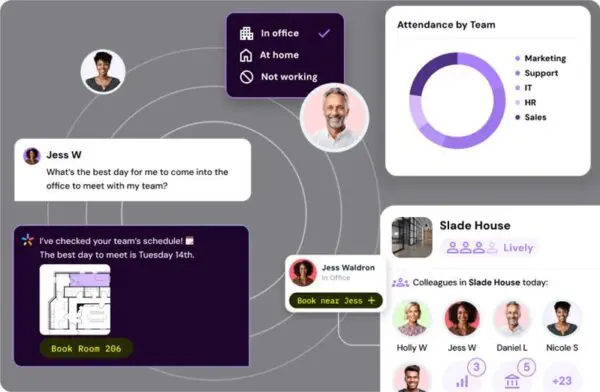5 Office Space Utilization Metrics for a Better Workplace in 2025

Space utilization (and its metrics) are going through somewhat of a heyday.
Cambridge Dictionary defines utilization as the “process of using something effectively”. Versus use, the definition for which is to put something to a particular purpose.
The focus on effectiveness is exactly why workplace leaders and innovators are looking at space utilization metrics to answer questions that have plagued organizations since the very first lockdown, like:
- How much space do we actually need?
- What types of spaces do we need?
- How do we build a better workplace?
Turns out, the answers lie in space utilization metrics.
Knowing which metrics to measure and how to measure them has been steadily moving up the list of priorities for workplace and CRE leaders. Space utilization ranked as the most important metric for workplace leaders surveyed by CBRE, with 46% relying on utilization data to plan their hybrid programs.
90% of workplace leaders are planning on increasing seat-sharing ratios as portfolio sizes decrease. This has left us all in a bit of a quandary – efficiency metrics like cost per square foot don’t cut it anymore. New workplace metrics are needed.
Space utilization metrics measure how effectively space is being used, and therefore, how effective the workplace is.
In this post, we’ll cover everything you need to know about office space utilization and five metrics to track for a better, more effective workplace in 2025.
What is office space utilization?
Office space utilization is a group of metrics that measure how effectively people are using a space. That could be by crowding it to its full capacity, not using it at all, and everything in between.
Office space utilization data paints a picture of how workspaces can be better used and managed. By measuring space utilization, companies can find opportunities to:
- Cut costs by spending less on underutilized spaces
- Only investing in workspaces employees will actually use
- Understand work habits and preferences to improve office design
- Making data-driven decisions with architectural design, office layout and even amenities
Space utilization metrics measure what’s actually happening in the office. They quantify employee behaviour and provides granularity that other occupancy data sources like badge check-ins and employee surveys can’t. That’s not to say either of these aren’t useful, though.
Space utilization is descriptive, predictive and prescriptive, so nailing down exactly which space utilization metrics to measure might seem like a lot to wrap your head around.
It doesn’t need to be that way.
Tracking these five office space utilization metrics will give you the certainty you need to improve your workplace experience and plan for the future.
1. Space utilization rate
What it is: The percentage of space in a building, floor or zone occupied by employees compared to the space’s total capacity. For example, if a floor has a 7% utilization rate, employees aren’t using 93% of the floor.
How to calculate space utilization rate:
Employees occupying the space / total capacity of that space = space utilization rate
How to use space utilization rate to build a better workplace: Create space utilization heat maps for office floor plans. The spaces seeing the highest traffic are the ones employees are getting the most value from. Are the most popular spaces collaborative, for individual focus or for something else? Increase the availability and amounts of these spaces for a better workplace experience.
2. Peak space utilization rate
What it is: The space utilization rate of office spaces when they’re at their peak, or highest, occupancy.
How to use peak space utilization rate to build a better workplace: If your office uses team neighborhoods, use peak utilization rate to allocate more space to teams that need it most. That way, teams will always be able to sit together on in-office days.
This Fortune 500 firm is using HubStar to master effective space allocation
Neighborhood overcrowding prevented teams from sitting together on in-office days, while space allocated to other teams sat empty. Find out how this organization used HubStar's space utilization software to master data-driven office design.

If you’re not using neighborhood office layouts, use peak space utilization to pinpoint overcrowded areas. Share this data with space planners and facilities management teams, so they can design floor plans to accommodate employee demand and/or find ways to spread employees into emptier areas.
3. Weekly Space Utilization Patterns
What it is: Daily space utilization rate over a standard working week that illuminates weekly occupancy patterns. For most organizations using hybrid working, weekly space utilization rate tends to peak on Tuesdays, Wednesdays and Thursdays and trough on Mondays and Fridays.
How to use weekly space utilization to build a better workplace: If occupancy is near capacity on specific days during the week, make changes to hybrid policies or encourage teams to come in on different days. If some days are complete ghost towns, soft close the emptiest spaces to save on utilities and cut carbon emissions.
4. Long-term space utilization trends
What it is: The overall direction of occupancy long-term. Similar to weekly space utilization, but with the intent to track how employees are using the office space over weeks, months and years. Patterns repeat themselves, while trends show how behaviour is changing medium and long-term. Space utilization trends measure how appealing the office is to employees, and how changes in the workplace impact occupancy.
How to use long-term space utilization trends to build a better workplace: Plot trends against events like hybrid policy changes, company meetings and renovations to measure their impact on occupancy. This can inform how policy changes are communicated internally and clearly show what employees want out of the office, so they don’t feel they’re being lured back in with gimmicky short-term benefits like free lunches.
How to Use Data to Design Your Hybrid Office
The right way to design a hybrid office is stumping even the most innovative and forward-thinking companies. Here's how to use workplace data to get it right.

5. Predicted Space Utilization Rate
What it is: Expected workplace space utilization levels based on current patterns and trends.
How to use predicted space utilization to build a better workplace: Ensure spend on utilities, facilities management and even office furniture is proportional to employee occupancy. For example, use predicted space utilization rate to order food for the cafeteria for the week ahead and cut back on food waste and carbon emissions.
In the long-term, predicted space utilization rate can inform repurposing of spaces, floor plans and real estate portfolio decisions like acquiring additional floors or slashing portfolio size.
Space utilization data sources
Accurately tracking these metrics requires data that’s both broad and granular. The conundrum that most organizations run into is that badge swipe data is broad but not granular, while occupancy sensor data is granular but not broad. Not to mention, installing sensors across your entire portfolio is far too costly for most organizations.
That’s why HubStar’s patented space utilization software is built to pull data from any source in real-time.
Start building a better workplace faster with HubStar's space utilization software
Say goodbye to guesswork. Start measuring these 5 space utilization metrics and making decisions that improve everyone's workplace experience.

Share this post
You might also like


















